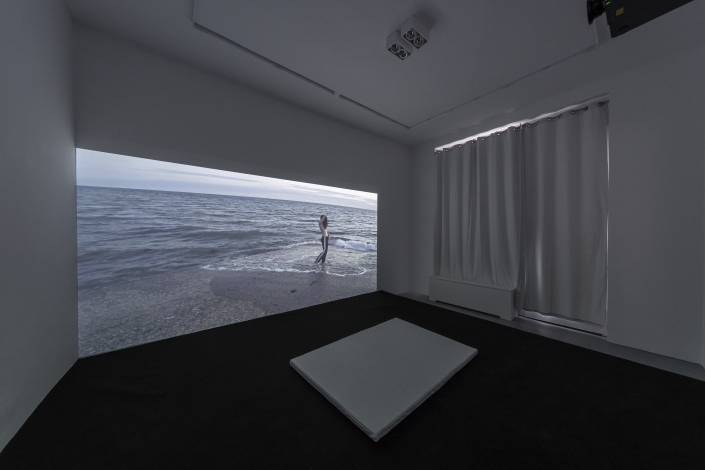DE
Anne Imhof Wave
1 Oktober – 13 November 2021
beacon freut sich die 2021 entstandene Videoarbeit Untitled (Wave) der deutschen Künstlerin Anne Imhof (*1978) zu präsentieren. Imhofs Praxis umfasst komplexe Performance-Zyklen, Choreografie, Malerei und Zeichnung, Musik, Installation und Skulptur, die sich zumeist aus der Perspektive der Malerei entwickeln. In Verbindungen von Mythologie, Subkultur, Mode und Körperkultur reflektieren ihre Werke den Zustand der Gegenwart.
Auch Untitled (Wave) (2021) lässt sich als malerisches Symbolbild verstehen, so erscheint uns darin eine, im wahrsten Sinne des Wortes, kraftvolle Geste der Wut, an der Schwelle zur Sehnsucht. Auf einer Betonfläche an der Atlantikküste der Normandie sehen wir darin die Künstlerin Eliza Douglas mit nacktem Oberkörper und wehenden Haaren. In rhythmischen Kreisbewegungen schwingt sie eine große, schwere Peitsche. Dazu erklingen zyklische, übereinander geschichtete Sounds aus Streichern, vor allem Geigen, einer Harfe und Bläsern, die in ihren Klangeigenschaften verändert sowie um computergenerierte Sounds ergänzt wurden. Sie enden in Meeresrauschen und erinnern in ihren freien Klangwellen teils an Debussys La Mer. Wuchtig schlägt Douglas auf die stetig wiederkehrenden Wellen des Meeres ein. Ihre Selbstvergessenheit steht ihrer Entschlossenheit entgegen, ein Ruck geht wiederholt durch ihren kraftvollen Körper. Sie erscheint uns in der, für Imhofs choreographierte ‘Duration-Performances’ typischen, rätselhaften Präsenz: auf der Schwelle zwischen körperlicher Anwesenheit und mentaler Abwesenheit, die einem unsichtbaren Verhaltenskodex der Coolness zu folgen scheint. Damit ist jeder Schlag immer auch ein Wagnis von Kontrollverlust über die Dynamik der Peitsche. Jeder Schlag enthält die potenzielle Verletzlichkeit des nackten, noch unversehrten Oberkörpers der Performerin. Zugleich ist sie auch Imhofs wiederkehrender Avatar, ein bekanntes Model, sowie Lebens- und Arbeitspartnerin der Künstlerin. Gelegentlich nähert sich Imhofs Kamera dem unversehrten Rücken dieser Frau, ihrem Nacken, ihrer Achsel und ihrer spitzen Brustwarze. Sie bewegt sich in Kreisbewegungen um die Performerin und ihre Peitsche. In einem Spiel von Schärfe und Unschärfe fokussiert sie dabei ihren Körper wie eine gestische Oberfläche: Die wehenden Haare, die der Performerin zuweilen die Sicht nehmen, ihren geöffneten Mund, das schäumende Wasser des Atlantiks, die untergehende Sonne zwischen ihren Beinen. Sie steht in Isolation, zugleich aber erreichen sie nicht endende Wellen – nur was oder wen sie symbolisieren bleibt offen. Ist sie die androgyne Gegenfigur der schaumgeborenen Venus, die die brutalen Dynamiken unserer Gegenwart spiegelt? Oder genauer: ihre sadistischen Machtverhältnisse? Wie nah liegen diese an der Grenze zum Masochismus? Wie nah liegt ihr Lustgewinn an der Demütigung?
Die Figur der nackten Eliza Douglas mag auch an die griechische Mythologie erinnern, doch ist sie das athletische Gegenbild zu der an den Felsen gefesselten Andromeda. Wie Xerxes erscheint sie über das Meer erzürnt, das dieser am Hellespont mit 300 Peitschenhieben bestrafen ließ. Der Atlantik ist Projektionsfläche eines gigantischen Ausmaßes. Und zugleich liegt darin seine Bürde, die spätestens seit Paul Gilroys Buch The Black Atlantic eine komplexe Analyseeinheit interkultureller Perspektive geworden ist. Er wies damit unter anderem eindringlich auf die Rolle der Sklaverei für die Westliche Moderne hin. Peitscht Imhofs Figur also unsere gescheiterten globalgeschichtlichen Vernetzungs-Entwürfe aus? Denn zuweilen dreht sich Douglas Körper langsam in unsere Richtung, bis ihre Peitschenschläge auf uns gerichtet sind, die wir uns auf einer weißen Ledermatratze in dem Symbolbild versenken. Ist es eine Gegenwartsbewältigung, die Wellen, die uns aus der Vergangenheit erreichen, uns immer noch einholen, auszupeitschen?
Eine Antwort will die Kunst uns nicht liefern, aber ihre endlose Sisyphusarbeit, schafft der Stimmung zwischen Wut und Versenkung unserer Gegenwart einen Raum und zeigt damit auch wie lebensnotwendig sie sein kann. Denn wie in Imhofs komplexen Symbolbildern kann man in der Betrachtung beides, sich in ihnen versenken und wach bleiben, für das was uns gegenwärtig erreicht oder das, was uns aus der Vergangenheit einholt.
Julika Bosch
Anne Imhof lebt und arbeitet in Berlin und New York. Internationale Bekanntheit erreichte sie mit umfassenden Ausstellungen und Performances, insbesondere den Zyklen Rage (2014-15), Deal (2015), Angst (2016) und Sex (2019-21). 2017 wurde sie auf der 57. Biennale von Venedig mit dem Goldenen Löwen für ihren Beitrag im Deutschen Pavillon geehrt. Zudem erhielt sie den Absolut Art Award (2017) und den Preis der Nationalgalerie (2015). Ihre Arbeiten wurden in internationalen Einzelausstellungen präsentiert, unter anderem im Palais de Tokyo (Paris, 2021), dem Art Institute of Chicago (2019), der Tate Modern (London, 2019), dem Hamburger Bahnhof (Berlin, 2016), der Kunsthalle Basel (2016), dem MoMA PS1 (New York, 2015) und dem Carré d‘Art – Musée d‘Art Contemporain in Nîmes (2014). Darüber hinaus hat sie an zahlreichen Gruppenausstellungen teilgenommen, darunter die Julia Stoschek Collection (Berlin, 2021), das MMK Frankfurt (2019 und 2014), Tai Kwun (Hongkong, 2019), La Biennale de Montréal (2016) und das Centre Pompi-dou (Paris, 2015).
Die Videoarbeit Untitled (Wave) (2021) ist neben beacon auch in der Ausstellung A Fire in My Belly der Julia Stoschek Collection und in Imhofs monumentaler Einzelausstellung Natures Mortes im Palais de Tokyo zu sehen.
EN
Anne Imhof Wave
1 October – 13 November 2021
beacon is delighted to present Untitled (Wave), a video work created in 2021 by the German artist Anne Imhof (b. 1978). Imhof’s practice encompasses complex performance cycles, choreography, painting and drawing, music, installations, and sculpture, most of which develop from the perspective of painting. Her work draws on allusions to mythology, subculture, fashion, and body culture to reflect on the contemporary condition.
Untitled (Wave) (2021) can also be perceived as a painterly symbolic image, appearing to us, in the truest sense of the word, as a powerful gesture of anger that verges on longing. Here we see the artist Eliza Douglas, her upper body naked, her long hair blowing in the wind. She stands on a concrete slab on the Atlantic coast of Normandy, swinging a long, heavy whip in rhythmic, circular strokes. This visual image is accompanied by cyclical, overlapping layers of sound: strings, mainly violins, a harp and wind instruments, their tonal qualities modified and augmented by computer-generated sounds. They culminate in the rushing of the ocean, in free waves of sound that are at times reminiscent of Debussy’s La Mer.
Douglas forcefully lashes the incessantly returning waves, her self-forgetfulness contrasting with her determination, as jolts repeatedly pass through her powerful body. To us, she seems an enigmatic presence, typical of Imhof’s choreographed “durational performances”: poised where physical presence and mental absence converge, she seems to act in accordance with an unseen code of coolness. Thus each stroke risks loss of control over the dynamic of the whip: intrinsic to every blow is the potential vulnerability of the performer’s naked, still unscathed, upper body. This woman is both Imhof’s recurrent avatar and a well-known model, as well as the artist’s partner and artistic collaborator. At times, Imhof’s camera closes in on her unscathed back, her neck, an armpit, an erect nipple. It travels in circles, tracing the movements of the performer and her whip. In an interplay of blurring and sharpness, it brings her body into focus as a gestural surface: the windblown hair that at times obscures the performer’s vision, her open mouth, the foaming waters of the Atlantic, the setting sun between her legs.
She stands there in isolation but is nevertheless reached by the incessant waves – only what or whom she symbolises is left open. Is she the androgynous counterpart to foam-born Venus, reflecting the brutal dynamic of our present? Or, more precisely, its sadistic power relations? How close are these to the boundaries of masochism? How close to humiliation is the pleasure gained? The figure of the naked Eliza Douglas might evoke Greek mythology, but as an athletic antithesis to images of Andromeda chained to the rocks. Like Xerxes, who had the waters of the Hellespont punished with three hundred lashes, she is enraged by the sea. The Atlantic is a field of projection on a gigantic scale. And at least since Paul Gilroy’s book The Black Atlantic appeared, it also bears the burden of having become a complex unit of analysis for production of an intercultural perspective. Among other aspects, it thus draws attention to the role of slavery in the West in the modern period. So is Imhof’s figure flogging our failed global-historical interconnectivity projects? For Douglas’s body at times turns slowly in our direction, until the lashes of her whip are directed at us, and we, on our white leather mattress, are ourselves immersed in the symbolic image. Is whipping the waves that come to us from the past, that continue to catch us up, a form of confronting the present? Art does not wish to provide us with an answer, but with its unending Sisyphean labours it creates space for a state of mind between rage and immersion of our present, thus demonstrating how vital its role can be. Because, as with Imhof’s complex symbolic imagery, as viewers we can both immerse ourselves in art and remain alert to what reaches us now in the present or what is catching up with us from the past.
Julika Bosch
translated by Anna Grant
Anne Imhof lives and works in Berlin and New York. She has achieved international recognition with extensive exhibitions and performances, in particular the cycles Rage (2014-15), Deal (2015), Angst (2016) and Sex (2019-21). In 2017 she was awarded the Golden Lion at the 57th Venice Biennale for her contribution in the German Pavilion. She also received the Venice Absolut Art Award (2017) and the Preis der Nationalgalerie, Berlin (2015). Her work has been presented in international solo exhibitions, including at the Palais de Tokyo (Paris, 2021), the Art Institute of Chicago (2019), Tate Modern (London, 2019), the Hamburger Bahnhof (Berlin, 2016), Kunsthalle Basel (2016), MoMA PS1 (New York, 2015), and the Carré d’Art – Musée d’Art Contemporain (Nîmes, 2014). In addition, she has participated in numerous group exhibitions, including at the Julia Stoschek Collection (Berlin, 2021), the MMK Frankfurt (2019 and 2014), Tai Kwun (Hongkong, 2019), La Biennale de Montréal (2016), and the Centre Pompidou (Paris, 2015).
The Untitled (Wave) (2021) video work presented at Beacon can also be seen in the A Fire in My Belly exhibition at the Julia Stoschek Collection and in Natures Mortes, Imhof’s monumental solo exhibition, at the Palais de Tokyo.








